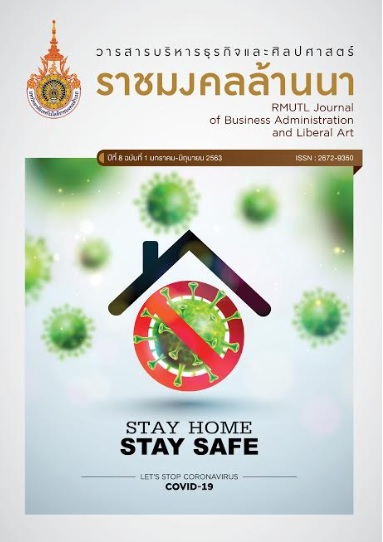Development guidelines for OTOP in response to Chinese consumer behavior with Thai government policy
Main Article Content
Abstract
This academic article is intended to present an overview of the Government policies, including Chinese consumer behavior analysis of the strengths and weaknesses of one district - one product policies, and all significant issues to developing one district - one products for export in China. The Thai government has defined policy for the government sector and banks in the state's regulation force regarding one district-one products from China. This article focuses on product advancement, knowledge training, standards development and packaging, distribution acquisition channels, as well as finding support for low-cost financial regulations and unstable government regulations.
It found that Chinese consumers demand a diversity of products, and focuses on the government and consumer behavior to do Strength, Weakness, Opportunity and Treatment analysis (SWOT). Regarding the results, it leads the way to development of one district - one product practices. The entrepreneur must design the products alike, according to Chinese consumers’ demand, by separating provinces according to those with more potential of buying demand, need for high quality products, and high price. The entrepreneur must develop products, and use packaging to create more value. Some parts of provinces in China have less potential, and entrepreneurs need to show the consumer to focus on the profitability and value of the products. Moreover, the government sector and related department should focus on the operators to have copyright or patents, in order to prevent duplication and imitation, which is the number one problem in China.
Article Details
บทความวิจัยนี้เป็นของลิขสิทธิ์
References
กองแผนงาน กรมการพัฒนาชุมชน. (2559). แผนยุทธศาสตร์กรมการพัฒนาชุมชน (พ.ศ.2560 - พ.ศ. 2564). กรุงเทพมหานคร: มปพ.
คณะกรรมการพัฒนาการเศรษฐกิจและสังคมแห่งชาติ สำนักนายกรัฐมนตรี. (2560). แผนพัฒนาเศรษฐกิจและสังคมแห่งชาติ ฉบับที่สิบสอง (พ.ศ. 2560–2564) . กรุงเทพมหานคร: มปพ.
ทิชากร เกษรบัว. (2556). การพัฒนาศักยภาพกลุ่มสินค้าหนึ่งตําบลหนึ่งผลิตภัณฑ์สู่วิสาหกิจขนาดกลางและขนาดย่อม กรณีศึกษา กลุ่มวิสาหกิจชุมชนแปรรูปอาหารจากกล้วย. วารสารการจัดการสมัยใหม่, 11(2), 74-86.
วทัญญู ใจบริสุทธิ์. (2559). การศึกษาโครงการหนึ่งตำบลหนึ่งผลิตภัณฑ์ (OTOP) ภายใต้วาทกรรมความเป็นสินค้า. วารสารเอเชียตะวันออกศึกษา, 20(2), 23-50.
Kittiphun Khongsawatkiat. (2002) “Isan Studies: “One Tambon, One Product " A Govern ment Policy Recovers Farmers' Debts and Fragile Rural Sector in Northeastern of Thailand" Presented in the 8th Conference on Thai Studies at Nakhon Phanom River View Hotel, Nakhon Phanom Province, Organized by Ramkhamheang University (9 – 12 January 2002).
กระทรวงพาณิชย์. (2560). กระทรวงพาณิชย์ พาณิชย์พร้อมใช้ประโยชน์จากนโยบาย One Belt One Road ส่งเสริมการค้าการลงทุนไทย-จีน. สืบค้นจาก http://www.moc.go.th/index.php/moc-news/2015-10-19-04-33-08
กรมพัฒนาชุมชน กระทรวงมหาดไทย. (2561). ระบบศูนย์ข้อมูลกลางเพื่อ การบริหารจัดเก็บและใช้ประโยชน์. สืบค้นจาก http://cddcenter.cdd.go.th
กรมพัฒนาธุรกิจการค้า กระทรวงพาณิชย์. (2561). พาณิชย์ พร้อม..! สร้างความแข็งแกร่งให้ผู้ประกอบการโอทอปเข้าสู่แวดวงธุรกิจเต็มตัว. สืบค้นจาก https://www.dbd.go.th/news_view. php?nid=469405191
ผู้จัดการ. (2559). “ร้านค้าประชารัฐสุขใจ” เปิดแล้ว 143 แห่งในปั๊ม ปตท.ทั่วไทย. สืบค้นจาก https://mgronline.com/smes/detail/9590000113859
ผู้จัดการ. (2561). “ทีซีซี” ผนึก “กรมการพัฒนาชุมชน” หนุนโอทอป สนับสนุนช่องทางการจำหน่ายในประเทศ-ตปท. สืบค้นจาก https://mgronline.com/business/detail/9610000016539
ศูนย์ข้อมูลเพื่อธุรกิจไทยในจีน. (2559). รายได้ชาวจีนใน 31 มณฑล/เมืองประจำปี 2559 เซี่ยงไฮ้ ปักกิ่ง และเจ้อเจียงติด 3 อันดับแรก. สืบค้นจาก https://thaibizchina.com/%E0%B8%A3%E0%B8%B2%E0%B8%A2%E0%B9%84%E0%B8%94%E0%B9%89%E0%B8%8A%E0%B8%B2%E0%B8%A7%E0%B8%88%E0%B8%B5%E0%B8%99%E0%B9%83%E0%B8%99-31-%E0%B8%A1%E0%B8%93%E0%B8%91%E0%B8%A5-%E0%B9%80%E0%B8%A1%E0%B8%B7/
สำนักงานส่งเสริมการค้าในต่างประเทศ ณ เมืองเซี่ยเหมิน. (2560) พฤติกรรมผู้บริโภคในตลาดจีน. สืบค้นจาก https://www.ditp.go.th/contents_attach/173089/173089.pdf
อีอีซี. (2561). อีอีซี “ร่วมมือ” อาลีบาบา กรุ๊ป ส่งสินค้าไทย ท่องเที่ยวไทยไปตลาดโลก พร้อมพัฒนาผู้ประกอบการไทย. สืบค้นจาก https://eeco.or.th
Chairman Migo Media. (2013). Part Three: Meet the 2020 Chinese Consumer. Retrieved from http://chairmanmigo.com/part-three-meet-2020-chinese-consumer/
Tradingeconomics. (2019). China Imports By Country. Retrieved from https://tradingeconomics.com/china/imports-by-country
YICAI. (2017). China and Thailand Promote OTOP Project's Chinese Market Entrance. Retrieved from https://www.yicaiglobal.com/news/china-and-thailand-promote-otop-project-chinese-market-entrance

